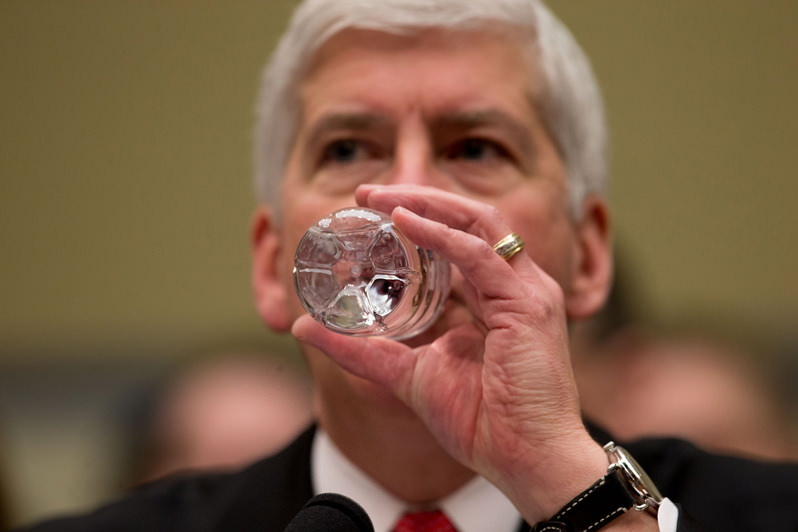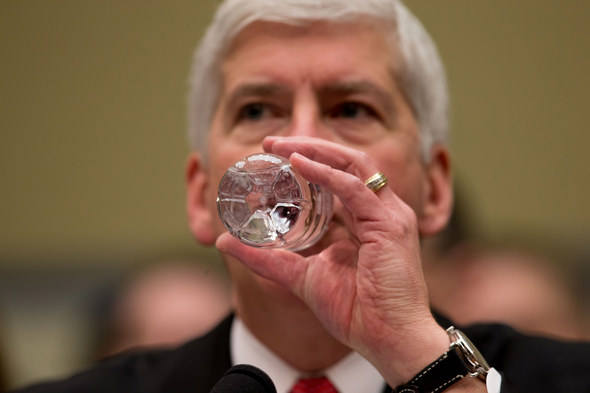A Day of Reckoning for Michigan Gov. Rick Snyder? Let’s Raise a Glass of Clean Water to That
He's unlikely to face criminal charges for the Flint contamination crisis, and he might not suffer from any of the pending lawsuits. Even so, the future could bring a certain kind of justice.

Michigan Gov. Rick Snyder drinks water, which was obviously not bottled in Flint, Mich., as he testifies before a House Oversight and Government Reform Committee hearing on the contamination of Flint’s tap water. (Andrew Harnik / AP)
If you’re waiting to see Michigan Gov. Rick Snyder brought to justice for his role in the Flint water crisis, don’t hold your breath. And if you’re planning to visit Flint while you wait, exercise caution before imbibing the H2O, even if state and federal regulators say the water quality has improved.
Despite the recent easing of the crisis, the Republican governor doesn’t deserve the slightest delay on his day of reckoning. He remains at the center of what can only be described as an ecological disaster—a mass, racially tinged poisoning, if you will—that has devastated a community that was once a hub of our industrial heartland but is now a shell of its former self. Snyder needs to be held to account, and the sooner the better.
The National Law Journal has reported that some 40 civil lawsuits have been filed on behalf of Flint residents injured by exposure to dirty water. Some have been lodged in state court; others have been filed in federal district court. Many are class actions, and several have named Snyder as a defendant.
In addition, both the FBI and the Michigan attorney general’s office have initiated investigations to determine whether any public or private parties should be held criminally responsible under state or federal law.
Despite these efforts, I’m skeptical that Snyder will ever be found civilly liable or guilty of any crimes. I am more optimistic that, ultimately, he will be made to face a form of political justice. Before explaining why, a little background on the water crisis is necessary.
More than 40 percent of Flint’s residents live below the poverty line, and 57 percent of residents are black. On April 25, 2014, their water supply was switched to the Flint River, away from the system that serves metropolitan Detroit, had serviced Flint for 50 years and draws its resources from Lake Huron.
Although the Snyder administration does not bear sole responsibility for the decision to tap into the Flint River, it helped mastermind the switch and formally approved it.
Ostensibly made to save Flint money, the changeover was part of Snyder’s plan to utilize his much-ballyhooed business acumen as a former corporate CEO and venture capital entrepreneur to impose austerity budgets on failing local governments, often by privatizing public resources and services and through the mechanism of partnerships between the public and private sectors.
Using an existing law that he succeeded in expanding, the governor installed “emergency managers” to run the affairs of cash-strapped municipalities like Detroit and Flint, overriding the authority of their elected mayors and city councils, which were reduced to little more than feckless enablers.
In March 2013, Flint’s emergency manager, with the concurrence of local officials, recommended that the city sever its water ties with Detroit and instead join a new regional agency—the Karegnondi Water Authority (KWA)—that would also be connected to Lake Huron. A month later, the Snyder administration officially endorsed the idea.
From a technical standpoint, there was an immediate problem with the plan’s implementation: The KWA’s pipelines hadn’t yet been laid and would not be fully installed for at least three years (they are now slated to be completed in June). To bridge the gap, Flint’s emergency manager contracted with Lockwood, Andrews & Newman, a high-powered private engineering firm, to equip Flint’s old water treatment plant to filter and deliver river water until the KWA system came online.
After Lockwood completed its work the following April, both state and local officials gave their assurances that the river water was just fine to use. As a high-ranking representative from the Michigan Department of Environmental Quality proudly crowed the day the switch was made, “Individuals shouldn’t notice any difference.”
But, of course, they did. Within weeks of their exposure to river water, residents complained about its foul odor and rusty brown color. They also reported skin lesions and rashes, hair loss and bouts of hypertension, memory failure and depression. In time, the complaints grew to include a suspected link between the river water and an outbreak of Legionnaires’ disease that began in June 2014 and eventually claimed nine lives.
The river was indeed the source of the problems. According to the online Bridge magazine of The Center for Michigan, technical experts assessing the suitability of tapping the river as a source of drinking water had noted as early as 2004 that the river was “highly susceptible” to contamination from at least 96 different sources.
The full extent of the river’s contamination was revealed when a research team led by Virginia Tech professor Marc Edwards, a leading authority on water resources, released the findings of a 2015 on-site study. The researchers found that the Flint River water was 19 times more corrosive than the Lake Huron supply. Once river water was unleashed, its corrosive quality began to erode the city’s antiquated underground system of lead pipes—the infrastructure of its water delivery system. As the pipes broke down, lead began to leach into residential water on a massive scale.
Based on water samples taken from 271 Flint homes throughout the summer, Edwards’ team discovered that some homes contained lead concentrations that met the Environmental Protection Agency’s definition of toxic waste.
As explained in an article written by Washington Post reporter Christopher Ingraham in January, under EPA standards lead levels are considered excessive if they exceed more than 15 parts per billion. When it comes to evaluations of entire communities, environmental regulators look at the “90th percentile” level of lead exposure in the samplings of homes that are tested. A community’s exposure is considered acceptable if 90 percent of homes fall below the EPA’s danger threshold. Public health concerns are triggered if 10 percent or more of tested homes exceed the standard.
According to Edwards, Flint’s 90th percentile reading came in at a whopping 27 parts per billion. Some residences measured alarmingly higher.
In August 2015, for example, Edwards and his colleagues tested the home of LeeAnne Walters, the Flint mother of four children who initially contacted the professor to seek his help. To minimize errors, they took 30 bottles of water from Walters’ home, collected at low-, medium- and high-flow rates. Subsequent lab tests revealed lead levels in the samples ranging from 200 parts per billion to an astonishing 13,200. At 5,000 ppb of lead, the EPA classifies water as hazardous waste.
Facing a growing public outcry and increasingly aggressive press coverage, the Snyder administration agreed to reconnect Flint to the Detroit water system in October 2015. Since then, Flint utility officials have boosted the amount of phosphate used by its water treatment plant to impede the corrosion of the city’s lead pipes.
Although such measures have slowly brought lead levels in Flint into compliance with EPA standards, a permanent fix will require the replacement of the city’s entire pipe network, including 20,000 to 25,000 service lines to individual homes. The estimated cost is upward of $1.5 billion.
The cost of compensating the people of Flint for the injuries they have sustained could also be staggering. The effects of lead poisoning, especially in terms of learning disabilities and developmental delay in children and slowed growth in the very young, sometimes take years to unfold, and can be crippling.
Adding insult to the harm inflicted on them, Flint residents were hit with the highest water bills in the nation until a county judge ordered a 35 percent rate reduction in August 2015.
Anyone seeking a preview of what a court case against Snyder might look like should review the governor’s March 17 testimony before the U.S. House Oversight and Government Reform Committee, particularly the cross-examinations of Snyder conducted by Elijah Cummings, D-Md., and Matt Cartwright, D-Pa.
In his written testimony for the hearing, Snyder maintained that he became aware of the lead levels in Flint’s water only on Oct. 1, 2015, when he “learned that our state experts [at the Michigan Department of Environmental Quality] were wrong.”
In addition to blaming his own environmental and public health offices, Snyder faulted “unaccountable bureaucrats” at the EPA who failed to come to the state’s rescue in a timely fashion. He assured the committee that he had acted swiftly to remediate the crisis when it was finally called to his attention, directing $67 million in state funds to “address both short-term needs and long-term solutions,” and he promised to appropriate $165 million more.
Cummings and Cartwright dismantled the governor’s claims piece by fabricated piece. In a style reminiscent of the Watergate hearings, they focused on what the governor knew about the water crisis and when he knew it.
Conceding that the EPA indeed should have acted sooner, they placed primary responsibility for the crisis squarely on the shoulders of the governor and his top department heads. Referencing a trove of emails, letters and other documents, they maintained that Snyder had ample warning of the unfolding crisis long before his administration approved Flint’s return to the Detroit water system in October.
Declaring that Snyder was “dripping with guilt,” Cartwright reminded the governor that “plausible deniability only works when it’s plausible.”
Cummings was even less sparing in his questioning and commentary. “There will now be an entire generation of children,” he charged, “who suffer from brain damage, learning disabilities and many other horrible effects of lead poisoning that were inflicted on them by Gov. Snyder’s administration. The governor’s fingerprints are all over this.”
In the hearing’s aftermath, the big question is whether the energy and conviction displayed by Cartwright and Cummings can be transferred to an actual courtroom in a case against Snyder. It’s one thing to hold a witness’s feet to the fire at a congressional hearing, but often quite another to bring the same person to trial.
I was reminded of this sober reality in an interview last week with Wayne State University Law School professor Peter Henning, a specialist in white-collar crime who has closely followed events in Flint.
To successfully prosecute Snyder for a violation of federal criminal law, Henning told me, the FBI and the Justice Department would have to prove beyond a reasonable doubt that the governor made a false statement under oath, destroyed evidence or otherwise obstructed justice. Snyder, in Henning’s view, left himself “enough wriggle room” to make such a prosecution improbable.
State criminal charges for the common-law crime of misconduct in office could present a more promising avenue of attack, Henning allowed, but most likely only for officials “lower down the food chain” from the governor.
Henning is also doubtful that any of the pending civil lawsuits will succeed in targeting Snyder. Under Michigan law, the governor is explicitly insulated from civil tort liability by the ancient doctrine of “sovereign immunity.” Derived from English law under the rubric that “the king can do no wrong,” some version of the principle exists in modified form in all 50 states, restricting damage actions against government. Michigan’s version is among the nation’s strictest.
Sovereign immunity concerns have driven many of the attorneys representing Flint residents to federal court. Last week, I spoke with one of them—veteran civil rights lawyer Bill Goodman, whose Detroit firm has joined with two other area law offices to file three suits, including a federal class action. (Full disclosure: I first met Goodman in 1977, when he was president of the National Lawyers Guild and I worked in the guild’s national office.)
Goodman explained that his theory of liability against Snyder would hold the governor and his administration accountable on 14th Amendment grounds for state actions that created the dangers endured by Flint residents, subverting their constitutional rights to life, liberty and property.
The theory is novel, risky and fraught with complexities. It’s what we in the legal profession sometimes designate a “case of first impression.” To win a judgment for money damages, or even to survive pretrial motions to dismiss, attorneys will have to overcome “qualified immunity” defenses that will be available to Snyder and other state officials. To make the challenges Goodman and company face more daunting, Snyder has spent $1.2 million in public funds to hire blue-chip private legal counsel to defend himself and his key advisers.
Ultimately, however, as innovative as Goodman’s strategy may be, the solution to the Flint water crisis—in the short term and long—probably will be more political than legal.
Most urgently, action is needed at the state and federal levels to establish mass disaster relief funds, well in excess of the amounts appropriated to date, to compensate the injured and upgrade Flint’s water system. At the same time, links must be drawn between the lead poisoning in Flint and lead contamination in other cities across the country. The EPA’s latest surveys estimate that $385 billion in water infrastructure improvements are needed to modernize the nation’s delivery systems.
That’s a lot of money, to be certain, but America is the wealthiest nation on earth. Spread over a period of years, the funding could readily be made available and would have the added benefit of being a strong source of job creation.
Finally, apart from bringing Snyder’s political career to a merciful end (his second and final term expires at the end of 2018), the Flint crisis should serve as a wake-up call to all of us: Access to clean, fresh water should be considered a fundamental human right that no one, especially a politician peddling austerity budgeting, can lawfully undermine or compromise.
If anything close to that can be accomplished, Snyder will have been brought to meaningful justice, even if he manages to dodge his day in court.
Independent journalism is under threat and overshadowed by heavily funded mainstream media.
You can help level the playing field. Become a member.
Your tax-deductible contribution keeps us digging beneath the headlines to give you thought-provoking, investigative reporting and analysis that unearths what's really happening- without compromise.
Give today to support our courageous, independent journalists.





You need to be a supporter to comment.
There are currently no responses to this article.
Be the first to respond.